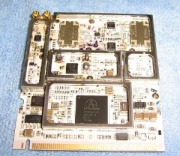430mhz data transfer
(→Doodle labs DL435-30) |
(→Doodle labs DL435-30) |
||
| Line 8: | Line 8: | ||
=====Doodle labs DL435-30===== | =====Doodle labs DL435-30===== | ||
| − | [[File:dl435.jpg]] | + | [[File:dl435.jpg|frameless]] |
[http://doodlelabs.com/products/sub-ghz-range/420-450-mhz-band-dl435.html Doodle labs DL435-30 product page] They also offer similar transcievers for a wide variety of frequencies. Including a configurable 150Mhz to 1Ghz 2W data transciever. However, they promote their radios for military use. So ideally I would avoid buying from them. | [http://doodlelabs.com/products/sub-ghz-range/420-450-mhz-band-dl435.html Doodle labs DL435-30 product page] They also offer similar transcievers for a wide variety of frequencies. Including a configurable 150Mhz to 1Ghz 2W data transciever. However, they promote their radios for military use. So ideally I would avoid buying from them. | ||
[http://www.qsl.net/n9zia/dl435/index.html DL435-30] | [http://www.qsl.net/n9zia/dl435/index.html DL435-30] | ||
Revision as of 10:46, 3 December 2012
Mesh idea is becoming popular, but is it really practical for anywhere other than extremely densly populated cities? Would be nice to have something more practical which could give access to those in the countryside, as well as on vehicles and boats.
One solution is to stick with 2.4GHz but use amplifiers and good antennas. The amplifiers are expensive.
A simple way to get around the range limitations of 2.4GHz wifi, could be to convert it directly down to 400Mhz, which a couple of wireless cards are able to do - the Doodle labs DL435-30 and Xargl communications something. Interestingly there is an amateur band just above 400Mhz. The problem is bandwidth - 2.4GHz wifi uses about 10MHz bandwidth - but can be configured to 5Mhz. The nice thing is that the software does not need much changing - the computer 'sees' the wireless card as a normal 2.4GHz device.
Other frequencies. 144Mhz amateur. HF?
Contents |
Doodle labs DL435-30
 Doodle labs DL435-30 product page They also offer similar transcievers for a wide variety of frequencies. Including a configurable 150Mhz to 1Ghz 2W data transciever. However, they promote their radios for military use. So ideally I would avoid buying from them.
DL435-30
KB9MWR's DL435-30 report
Doodle labs DL435-30 product page They also offer similar transcievers for a wide variety of frequencies. Including a configurable 150Mhz to 1Ghz 2W data transciever. However, they promote their radios for military use. So ideally I would avoid buying from them.
DL435-30
KB9MWR's DL435-30 report
Most reports listed here have used the cards with the Ubiquiti Routerstation or Routerstation Pro, a compact router board with three miniPCI slots. They are powered by power over ethernet, so would be easy to put somewhere high up, with a sing cable for power and data. Ubiquiti stopped making these routers in 2011, and they are difficult to find. It would be possible to use an old laptop with the unnessary components removed. Or even a desktop computer, using mini PCI to PCI converter. Having a storage disk with the router could be useful, but if its going to be in a precarious high up location, probably best to keep it minimal and have stuff like that on the ground. Its a shame the Raspberry Pi does not have a miniPCI.
Maybe it is possible to use it with other routers with a mini PCI slot. There are many listed in the compatible hardware list on DD-WRT site, for example the cisco lynksys WAP54G - it would be interesting to know if this works with the doodle labs cards. [1]
the doodle labs cards have tiny MMCX connectors for connecting the antenna feeder. So we would need MMCX pigtail cable to connect to a more robust connector like SMA or N-type.
Modifying Consumer Off the Shelf Wireless LAN devices for specialized amateur use
software
antennas
DXzone's 70cm antenna links 440mhz j-pole design Build A 9 dB, 70cm, Collinear Antenna From Coax
amplifiers for 70cm
the UK foundation amateur power limit is 10w. 500w 70cm amplifier kit assembly guide the mosfet datasheet rfham.com has prebuilt Module PA 432MHz 500W